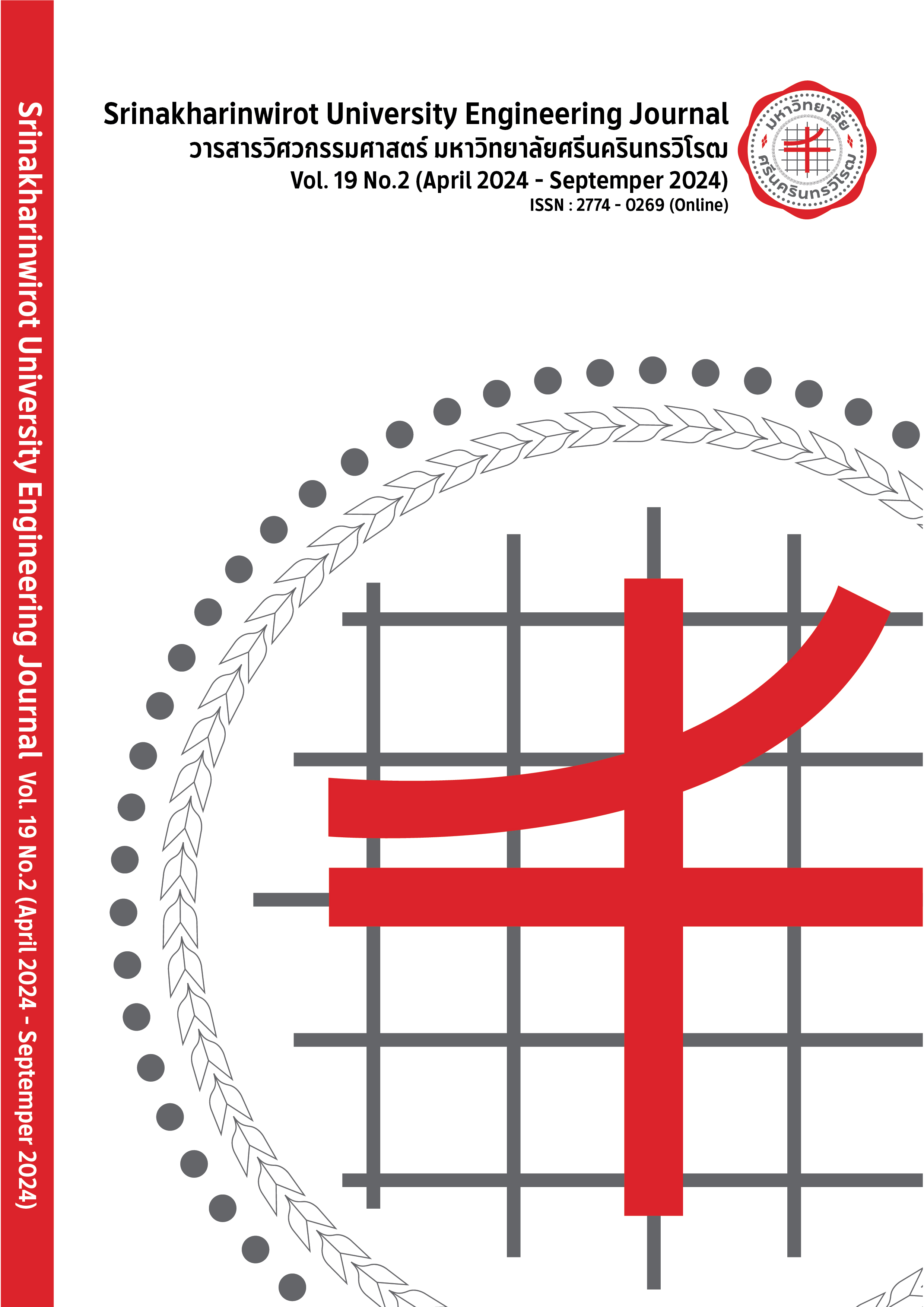Study on the Effect of Refrigerator with Phase Change Material
Main Article Content
Abstract
This research studies the effects of using phase change material in the cooling system of a 105 L single door refrigerator. Installed the phase change material together with the cooling pipe instead of the original evaporator position, with melting temperature of -15 ℃. This was a load pull-down test with a final temperature of 6 ℃ and an average initial temperature of 35 ℃, the comparison with and without phase change material. Consider the average of the pull-down time of the load temperature, the temperature in cabinet of refrigerator, the compressor run time, and the energy consumption. The results of the experiment found that the refrigerator with phase change material had a time to pull-down the load temperature of more than 3 minutes, accounting for 0.61 %, the increase is only slight and has no effect on the cooling system. The pull-down time of temperature in cabinet reduce up to 94 minutes, is 33.09 %. The compressor operating time decreased by 88 minutes is 25.00 % and reduced energy consumption by 11.930 W is 17.77 %. When comparison without phase change material had a time to pull- down the load temperature of 485 minutes, the pull- down time of temperature in cabinet of 284 minutes, there was a compressor operating time of 352 minutes, and energy consumption by 67.131 W. The results indicate that the use of phase change materials has a positive impact on the cooling system.
Article Details

This work is licensed under a Creative Commons Attribution-NonCommercial-NoDerivatives 4.0 International License.
Copyright belongs to Srinakharinwirot University Engineering Journal
References
B. Gin, M.M. Farid and P.K. Bansal, “Effect of door opening and defrost cycle on a freezer with phase change panels,” Energy Conversion and Management, vol. 51, pp. 2698–2706, 2010.
S. B. Amara, O. Laguerre, M.C. Charrier-Mojtabi, B. Lartigue and D. Flick, “PIV measurement of the flow field in a domestic refrigerator model: comparison with 3D simulations,” Int. J. Refrig, vol. 31, pp. 1328–1340, 2008.
H. Chuang, K. Wu, W. Weng and C. Lee, “Dynamic modulation of voltage excitation angle to optimize energy consumption of refrigerator,” International journal of refrigeration, vol. 81, pp. 151–162, 2017.
J.M. Belman, J. Navarro-Esbrí, D. Ginestar and V. Milian, “Steady state model of a variable speed vapor compression system using R134a as working fluid,” Int J Energy Res, vol. 34, no. 11, pp. 933–945, 2010.
P.S. Raveendran and S.J. Sekhar, “Performance studies on a domestic refrigerators retrofitted with building-integrated water- cooled condenser,” Energy Build, vol.134, pp.1-10, 2017.
A.C. Marques, G.F. Davies, G.G. Maidment, J.A. Evans and I.D. Wood, “Novel design and performance enhancement of domestic refrigerators with thermal storage,” Applied Thermal Engineering, vol. 63, pp. 511-519, 2014.
M.M. Joybari, F. Haghighat, J. Moffat and P. Sra, “Heat and cold storage using phase change materials in domestic refrigeration systems: the state-of-the-art review,” Energy Buildings, vol.106, pp.111–24, 2015.
G. Sonnenrein, A. Elsner, E. Baumhögger, A. Morbach, K. Fieback and J. Vrabec. “Reducing the power consumption of household refrigerators through the integration of latent heat storage elements in wire-and-tube condensers,” Int J Refrig, vol. 51, pp, 154–60, 2015.
Z. Liu, D. Zhao, Q. Wang, Y. Chi and L. Zhang, “Performance study on air-cooled household refrigerator with cold storage phase change materials,” Int J Refrig, vol. 79, pp. 130–142, 2017.
C. Marques, G. Davies, G.G. Maidment, J.A. Evans and I.D. Wood, “Novel design and performance enhancement of domestic refrigerators with thermal storage,” Applied Thermal Engineering, vol. 63, pp. 511-519, 2013.
R. Elarem, S. Mellouli, E. Abhilash and A. Jemni. “Performance analysis of a household refrigerator integrating a PCM heat Exchanger,” Applied Thermal Engineering, vol. 125, pp.1320–1333, 2017.
L. Abdolmaleki, S.M. Sadrameli and A. Pirvaram. “Application of environmental friendly and eutectic phase change materials for the efficiency enhancement of household freezers,” Renewable Energy, vol. 145, pp. 233-241, 2020.
A. Pirvaram, S.M. Sadrameli and L. Abdolmaleki. “Energy management of a household refrigerator using eutectic environmental friendly PCMs in a cascaded condition,” Energy, vol. 181, pp. 321-330, 2019.
B.O. Bolaji, A.O Akintaro, O. Alamu and T. Olayanju, “Design and Performance Evaluation of a Cooler Refrigerating System Working with Ozone Friendly Refrigerant,” The Open Thermodynamics Journal, vol. 6, pp. 25-32, 2012.
Y. Mona, S. Thiangchanta and C. Chaichana. “Electricity peak load reduction of a refrigerator using phase change material,” Energy Reports, vol. 8, pp. 48-53, 2022.
ISO, International Standard - 8187, Household Refrigerating Applications (Refrigerators/Freezers) Characteristics and Test Methods, 1991.
M.I.H. Khan, “Conventional refrigeration systems using phase change material: a review,” Int. J. Air-Cond. Refrig, vol. 24, no. 03, 1630007, 2016.
S.B. Riffat and X. Ma., “Improving the coefficient of performance of thermoelectric cooling systems: a review,” Int. J. Energy Res, vol. 28, no. 9, pp. 753–768, 2004.
I. N. Suamir, I. M. Rasta, Sudirman and K. M. Tsamos, “Development of corn-oil ester and water mixture phase change materials for food refrigeration applications”, Procedia, vol. 16, pp. 198-206, 2019.
O. G. Zarajabad, R. Ahmadi. “Numerical investigation of different PCM volume on cold thermal energy storage system,” Journal of Energy Storage, vol. 17, pp. 515–524, 2018.


